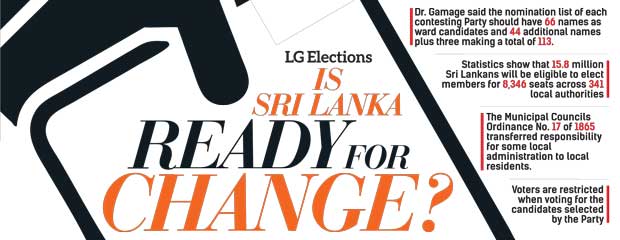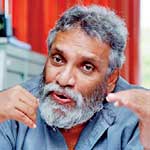Reply To:
Name - Reply Comment

 The Local Government Elections are just around the corner. The LG elections scheduled to take place on February 10 has become a much talked about topic in the country, mainly because of the new electoral system for the polls. Many commended the decision to abolish the preferential voting system and establishing the mixed electoral system. Some have raised objections to the removal of the preferential voting system.
The Local Government Elections are just around the corner. The LG elections scheduled to take place on February 10 has become a much talked about topic in the country, mainly because of the new electoral system for the polls. Many commended the decision to abolish the preferential voting system and establishing the mixed electoral system. Some have raised objections to the removal of the preferential voting system.
Statistics show that 15.8 million Sri Lankans will be eligible to elect members for 8,346 seats across 341 local authorities. This year (2018) also marks the first time in Sri Lankan history that an election will be held under the mixed electoral system.
Terance Purasinghe, Senior Lecturer in Political Science at the University of Sri Jayawardenapura, in an interview with the explained about the history of Local Government Structure in Sri Lanka.
History of Local Government Structure in Sri Lanka
 “Sri Lanka has a long history of Local Government. According to the Mahavamsa the earliest Sinhalese settlements, dating to the 4th century BC, were village based. These villages were used by the Sinhalese kings as a unit of administration,” Purasinghe said.
“Sri Lanka has a long history of Local Government. According to the Mahavamsa the earliest Sinhalese settlements, dating to the 4th century BC, were village based. These villages were used by the Sinhalese kings as a unit of administration,” Purasinghe said.
Sri Lanka has a long history of Local Government. According to the Mahavamsa the earliest Sinhalese settlements, dating to the 4th century BC, were village based. These villages were used by the Sinhalese kings as a unit of administration
He stated that each village was independently administered and village Councils (Gam Sabhas) administered local affairs, addressed people’s grievances and settled minor disputes. The village based administration continued for centuries in one form or the other.
Under the British rule
The Municipal Councils Ordinance No. 17 of 1865 transferred responsibility for some local administration to local residents. The Village Communities Ordinance No. 26 of 1871 introduced Village Committees for local administration and Rural Courts for judicial administration. Purasinghe went to say that sanitary Boards Ordinance No. 18 of 1892 created bodies to provide a number of public health services such as electricity, drainage, public conveniences, markets, dairies, laundries and water supply in small towns.
The Local Boards Ordinance No. 13 of 1898 created Local Health and Sanitation Boards for larger towns.
The Urban Councils Ordinance No. 61 of 1939 created Urban Councils in the largest towns in the country.
Post independence
The Town Councils Ordinance No. 3 of 1946 created Town Councils. “The 1979 Tennakoon Commission recommended that District Development Councils (DDC) be established to carry out development functions currently carried out by the Central Government. The District Councils Act No. 35 of 1980 was passed by Parliament and 24 DDCs were created,” he said.
Parliament passed the Pradeshiya Sabha Act No. 15 of 1987 on 15 April 1987 and established Pradeshiya Sabhas.
 Distribution of local authorities by province/district in November 2017
Distribution of local authorities by province/district in November 2017
By recent amendment, the mixed voting system (Majority and Proportional) has been introduced for Local Government, Purasinghe said.
Making LG elections more local
 Dr. Sujata Gamage, a senior policy fellow and leading researcher at LIRNEasia, said the new method is expected to make elections more local by incorporating first-past-the-post (FPP) contests to elect members by wards which are smaller sub-units in a local authority area.
Dr. Sujata Gamage, a senior policy fellow and leading researcher at LIRNEasia, said the new method is expected to make elections more local by incorporating first-past-the-post (FPP) contests to elect members by wards which are smaller sub-units in a local authority area.
Comprehensively explaining the new electoral system, she said, “The new method is still a proportional representation method because the FPP contests are carried out within a larger proportional representation (PR) framework. The votes received by each Party at the ward level will be totaled to obtain each Party’s share of votes in the local authority as a whole. In the Colombo Municipal Council, for example, the larger PR framework has 110 seats.”
Dr. Gamage said the nomination list of each contesting Party should have 66 names as ward candidates and 44 additional names plus three making a total of 113. She stated that if Party A, say, wins 50% of the total votes, it is entitled to 55 of the 110 seats in the council. If the same Party wins 40 out of 66 FPP seats, it has 15 seats remaining from its PR entitlement. The Party secretary will nominate additional members from the list to fill the remaining seats. Similarly, candidates from other Parties get returned according to each Party’s PR entitlement.
“In the Colombo Municipal Council or CMC, for example, we have 47 wards returning 66 members. A Ward in Colombo is typically no larger than a Grama Niladhari Division (GND). The number of Members to be returned is higher than the number of wards because there are several multi-member wards in the CMC. Votes will be cast and counted at the ward level. In a dual-member ward, for example, each Party will field two candidates and the Party that obtains the most votes in that ward gets to return both candidates as councilors,” said Dr. Gamage.
Huge increase in number of councilors
The worst part about the new method is the increase in the size of local councils, Dr. Gamage opined. She claimed that the number of councilors in CMC, for example, would increase from 53 in 2015 to 117 in 2018. This amounts to 107% increase! “This is what happens when you try to have the PR cake, but get your own representative too,” she remarked.
The number of Members to be returned is higher than the number of wards because there are several multi-member wards in the CMC. Votes will be cast and counted at the ward level. In a dual-member ward, for example, each Party will field two candidates
“Secondly, having more councilors will not necessarily make the council more accountable. Thirdly, the new method concentrates much power on the political Parties.
Voters are restricted when voting for the candidates selected by the Party. Additional Members are also hand-picked by the Party,” she stated. Meanwhile, she noted that if for some reason an elected Member returned from a particular ward is disqualified, no by-election will be held.
However, she made an interesting suggestion for the confused citizen. “Electoral systems cannot solve all problems. A functioning democracy requires the active participation of citizens, the middle class in particular. Why not join a political Party and try to fix your Party from the bottom?” she asked.
Nomination pores, instead of manapa pores
 In an interview with the Dailly Mirror , National Elections Commission (NEC) Chairman Mahinda Deshapriya said campaigns can be limited to each ward, bringing down campaign costs significantly as candidates contest at ward level in the forthcoming LG elections under the new electoral system.
In an interview with the Dailly Mirror , National Elections Commission (NEC) Chairman Mahinda Deshapriya said campaigns can be limited to each ward, bringing down campaign costs significantly as candidates contest at ward level in the forthcoming LG elections under the new electoral system.
Speaking on the controversial decision through which 25% for female representation was given, Deshapriya said out of the total number of members representing a political party at the LG body, the females must constitute 25%. There is a clause which states that if any party obtains only one or two seats, there is no requirement to appoint a female, but if there are three seats, the third member
out of the total number of members representing a political party at the LG body, the females must constitute 25%. There is a clause which states that if any party obtains only one or two seats, there is no requirement to appoint a female, but if there are three seats, the third member must be a female
must be a female. “Most importantly, there will not be any manapa pores. Instead, there were nomination pores,” he said.
Deshapriya underscored that each voter will be presented with a ballot paper which is quite simple at the polling booth on February 10th. He said it will consist of a set of party symbols and the names corresponding to the symbols. Names of the candidates will not appear on the ballot. The names of any of the candidates, well-known or not, will not appear on the ballot. Voters will have to vote for the party symbol. Candidates will have to maintain a good image in order to win the hearts of people in their respective electoral. Asked how the counting and calculation of votes will be done, Deshapriya said votes will be cast and counted at the ward level. In a dual-member ward, for example, each party will field two candidates and the party that obtains the most votes in that ward gets to return both candidates as councilors.
According to him, the votes received by each party at the ward level will be totaled to obtain each party’s share of votes in the local authority in total.
‘No party will win the majority’
-Hettiarachchi
Executive Director of People’s Action for Free and Fair Elections (PAFFREL) Rohana Hettiarachchi said, “As far I am concerned, preferential voting system should have been there. Under the preferential voting system, people can select their favorite politicians for posts in the local councils. It is the best voting system for a democratic country like Sri Lanka. However, I believe that the concept of respective politicians to be responsible for their own electoral is very good. Ultimately, it is better for the general public.
Last but not least, the decision to increase female representation is impressive and much needed. We believe corruption and frauds will be reduced when females are in power. Generally females are quite reluctant to engage in corruption and frauds when compared with males in our country. As women are generally good at activities like healthcare, education and cleaning, we, the PAFFREL hope that this change will positively impact the country as a whole. The quality of Government service will rise through their contributions.
We remember at the 2010 Presidential Elections, there were allegations of ‘computer jilmaat’ (frauds). As the ballot papers will be counted in the polling stations itself, there will be no space for such activities and even for such allegations to be made. However, I think there will be problems in establishing the sabhas because no party will win the majority.”
‘Election violations are zero’
- Tennakoon
Executive Director of Campaign for Free and Fair Elections (CaFFE) Rajith Keerthi Tennakoon said, “As representatives of elections monitoring teams we are very satisfied with the change. Elections violations are almost zero, which is very impressive. Expenses of candidates, which used to be millions and billions, are very low. Instead of boasting about themselves, they work for the sake of their political parties The candidates are encouraged somewhat and are pushed to work for the people in order to win their hearts. We didn’t hear of many incidents regarding the distribution of goods which was a feature of the manapa poraya. Candidates are also totally aware that if they are caught up while violating election rules, they can be unseated as per the regulations. However, we should praise the Government for making the change even after the delay.”
said Tennakoon.

Pics by Nisal Baduge and Damith Wickramasinghe